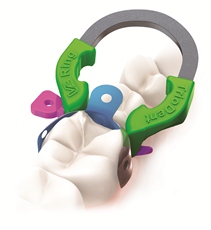Clinical Evaluations
V3 Ring Sectional Matrix System
Consultants’ Comments
- “The new V3 Ring Sectional Matrix System works better for wider proximal boxes when compared to the previous version.”
- “This system creates the most anatomic, tight contacts of any system I have ever used.”
- “Consistent separation of teeth and less for me to trim in the interproximal area.”
- “Rings are tight, wedges are smooth and both are gentle to tissue.”
- “Stacking the rings for multiple restorations is somewhat difficult.”
Description
The V3 Ring Sectional Matrix System has three components: the V3 ring, a separator ring with V-shaped autoclavable tines, the V3 matrix and the Wave-Wedge. The V3 Ring, which is available in Universal and Narrow sizes, is made of nickel-titanium alloy, which provides increased tension to establish a sound contact area. The V3 Universal ring (green) is a newly designed version of the original V-Ring. A narrow ring (yellow) is available for use on smaller teeth. The tines are reinforced glass fiber and are designed to match buccal and lingual contours of posterior teeth to prevent the ring from collapsing into preparations with wide proximal boxes. The matrix features a placement tab with removal holes for use with pin tweezers. The Wave-Wedge is plastic with flexible wings and a hollow underside to accommodate the gingival papilla. The starter pack contains one Universal and one Narrow ring, two pin tweezers, one forceps, V3 matrices, and Wave-Wedges. Thirty consultants evaluated the V3 Ring Sectional Matrix System in more than 900 clinical applications. This product received a 96% clinical rating.
Product Features
The starter pack that was evaluated contained the V3 Ring Sectional Matrix System in a small compartmentalized plastic box with illustrated instructions. Additional training information can be obtained from the company website or supplied on a CD or DVD. The color-coding and different sizes of the wedges are very useful and they adapt well to interproximal spaces. The two ring sizes are adequate for all posterior teeth with the Narrow ring being very effective for smaller teeth. The combination of the tension in the ring and the tines adapts the sectional matrix band to the proximal contours of the teeth to reduce excess composite and produce a reliable and consistent proximal contact. The forceps/ring combination is stable and the tension in the spring remains constant, although it can be reset by using the forceps and firmly squeezing the tines together. The thicker tines do not allow placement in some situations; however, the manufacturer is working to improve this. Eighty-seven percent of consultants rated the V3 Ring Sectional Matrix System better than the current matrix system they were using and 90% would recommend it.


